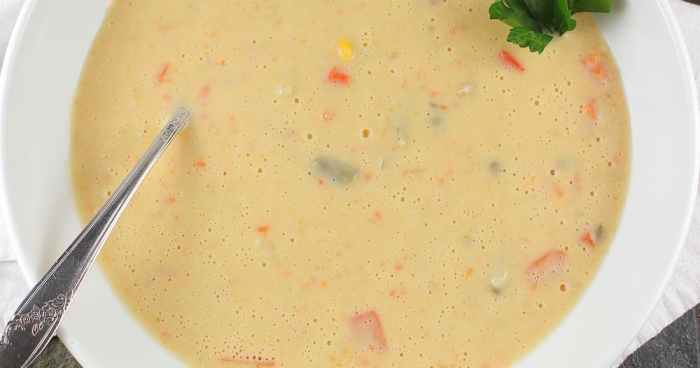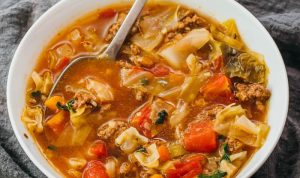Stampede Soup Recipe Variations
Stampede soup recipe – Stampede Soup, a hearty and flavorful stew, offers endless possibilities for customization. Its adaptability allows for diverse protein sources, spice levels, and cooking methods, ensuring there’s a perfect version for every palate and occasion. Let’s explore some exciting variations.
Beef Stampede Soup
This classic version delivers a rich, savory flavor profile. The beef provides a substantial base, complemented by the heartiness of the beans and vegetables. The slow cooking process allows the flavors to meld beautifully, resulting in a deeply satisfying soup.
- 1 lb beef stew meat, cubed
- 1 tbsp olive oil
- 1 onion, chopped
- 2 carrots, chopped
- 2 celery stalks, chopped
- 1 (15 oz) can diced tomatoes
- 1 (15 oz) can kidney beans, drained and rinsed
- 4 cups beef broth
- 1 tsp dried thyme
- 1 bay leaf
- Salt and pepper to taste
Chicken Stampede Soup
A lighter alternative to the beef version, this recipe features tender chicken and a brighter flavor profile. The chicken’s mild taste allows the other ingredients to shine, creating a balanced and refreshing soup.
- 1 lb boneless, skinless chicken breasts, cubed
- 1 tbsp olive oil
- 1 onion, chopped
- 2 carrots, chopped
- 2 celery stalks, chopped
- 1 (15 oz) can diced tomatoes
- 1 (15 oz) can pinto beans, drained and rinsed
- 4 cups chicken broth
- 1 tsp dried oregano
- Salt and pepper to taste
Vegetarian Stampede Soup
This hearty vegetarian version proves that Stampede Soup can be just as satisfying without meat. The combination of vegetables and beans creates a rich and complex flavor profile, perfect for a meatless meal.
- 1 tbsp olive oil
- 1 onion, chopped
- 2 carrots, chopped
- 2 celery stalks, chopped
- 1 (15 oz) can diced tomatoes
- 1 (15 oz) can black beans, drained and rinsed
- 1 (15 oz) can corn, drained
- 4 cups vegetable broth
- 1 tsp cumin
- 1/2 tsp chili powder
- Salt and pepper to taste
Spicy Stampede Soup
For those who enjoy a kick, this recipe incorporates a blend of chili peppers to create a fiery and flavorful soup. The careful selection of peppers allows for a balanced heat level, ensuring a delicious and memorable experience. We’ll use a combination of 1-2 serrano peppers (medium heat) and a pinch of cayenne pepper (high heat) for a good balance.
- 1 lb ground beef or chicken
- 1 tbsp olive oil
- 1 onion, chopped
- 2 cloves garlic, minced
- 1-2 serrano peppers, finely chopped
- 1/4 tsp cayenne pepper
- 1 (15 oz) can diced tomatoes
- 1 (15 oz) can kidney beans, drained and rinsed
- 4 cups beef or chicken broth
- 1 tsp cumin
- Salt and pepper to taste
Slow Cooker Stampede Soup
This convenient method requires minimal effort and yields a deeply flavorful soup. The slow cooking process allows the flavors to develop fully, resulting in a tender and delicious meal. Adjust cooking time based on your slow cooker and desired tenderness.
- 1 lb beef stew meat, cubed
- 1 onion, chopped
- 2 carrots, chopped
- 2 celery stalks, chopped
- 1 (15 oz) can diced tomatoes
- 1 (15 oz) can kidney beans, drained and rinsed
- 4 cups beef broth
- 1 tsp dried thyme
- 1 bay leaf
- Salt and pepper to taste
Cook on low for 6-8 hours or high for 3-4 hours.
Ingredient Exploration: Stampede Soup
Each ingredient plays a vital role in creating the signature flavor and texture of Stampede Soup. Understanding their individual contributions enhances your appreciation and allows for creative substitutions.
Ah, stampede soup, a culinary whirlwind! One might argue that achieving its robust flavour requires a similarly robust base, and while I wouldn’t recommend using actual stampeding animals, a magnificent foundation can be found by consulting this excellent guide for a soup recipe from turkey carcass , which offers a depth of flavour that perfectly complements the hearty spices of a truly spectacular stampede soup.
The resulting broth, I assure you, will be anything but pedestrian.
The Role of Key Ingredients
The foundation of Stampede Soup lies in the harmonious blend of its core components. The protein source (beef, chicken, or vegetarian alternative) provides heartiness and richness. Beans add texture, fiber, and a subtle earthy flavor. Onions, carrots, and celery form the aromatic base, contributing sweetness and depth. Tomatoes provide acidity and brightness, balancing the richness of the other ingredients.
Broth creates the liquid foundation, infusing the soup with flavor. Finally, herbs and spices add complexity and warmth.
Bean Comparison
Different beans impart unique characteristics to Stampede Soup. Kidney beans offer a firm texture and slightly sweet flavor. Pinto beans provide a creamy texture and mild taste. Black beans add a slightly earthy and robust flavor. Each bean type contributes different nutritional benefits, including fiber, protein, and various vitamins and minerals.
Herb and Spice Preparation
Fresh herbs and spices significantly elevate the flavor profile of Stampede Soup. Fresh herbs like parsley, cilantro, or oregano should be added towards the end of cooking to retain their vibrant flavors and aromas. Spices such as cumin, chili powder, or thyme can be added earlier in the cooking process to allow their flavors to fully develop.
Cooking Techniques: Stampede Soup
Mastering the cooking process ensures a perfectly balanced and flavorful Stampede Soup. Precise measurements and attention to detail are key to achieving optimal results.
Step-by-Step Stampede Soup
First, sauté the aromatics (onions, carrots, celery) until softened. Then, brown the meat (if using) and add it to the pot. Stir in the tomatoes, beans, broth, and spices. Bring to a boil, then reduce heat and simmer until the meat is tender and the flavors have melded (approximately 1-2 hours for stovetop, longer for slow cooker). Adjust seasoning to taste.
Finally, thicken as desired (see below).
Stampede Soup Recipe Table
| Ingredient | Quantity | Unit | Notes |
|---|---|---|---|
| Beef Stew Meat | 1 | lb | Cubed |
| Onion | 1 | medium | Chopped |
| Carrots | 2 | medium | Chopped |
| Celery | 2 | stalks | Chopped |
| Diced Tomatoes | 1 | (15 oz) can | Undrained |
| Kidney Beans | 1 | (15 oz) can | Drained and rinsed |
| Beef Broth | 4 | cups | |
| Thyme | 1 | tsp | Dried |
| Bay Leaf | 1 | ||
| Salt and Pepper | To taste |
Thickening Methods
Several methods can be used to thicken Stampede Soup. A roux (a mixture of butter and flour) creates a creamy texture. A cornstarch slurry (cornstarch mixed with cold water) provides a smooth consistency. Pureed vegetables (such as carrots or potatoes) add thickness and enhance the flavor.
Serving Suggestions & Variations

Source: theferventmama.com
Stampede Soup’s versatility extends to its serving styles and accompanying dishes. Consider the occasion and dietary needs when choosing accompaniments.
Side Dish Suggestions
Cornbread, crusty bread, or biscuits provide excellent vehicles for soaking up the flavorful broth. A simple green salad adds freshness and balances the richness of the soup. For a heartier meal, consider serving with grilled cheese sandwiches or roasted vegetables.
Ingredient Substitutions
Many ingredients can be substituted based on availability or preference. Different types of beans can be used interchangeably. Other vegetables, such as potatoes or squash, can be added for added flavor and texture. Vegetable broth can be substituted for beef or chicken broth to create a vegetarian version.
Serving Suggestions Table

Source: cloudfront.net
| Occasion | Serving Style | Accompaniments | Description |
|---|---|---|---|
| Casual Dinner | Bowls | Cornbread, salad | A comforting and satisfying weeknight meal. |
| Potluck | Large Crockpot | Biscuits, crackers | Easy to transport and serve in a crowd-pleasing manner. |
| Special Occasion | Individual Ramekins | Grilled cheese, roasted vegetables | A more elegant presentation for a festive gathering. |
Stampede Soup’s History and Cultural Significance: Stampede Soup Recipe
While the precise origins of Stampede Soup remain elusive, its evolution and cultural significance are fascinating to explore. Its hearty nature and adaptability have contributed to its enduring popularity.
Historical Overview

Source: jessiesfoodfaithandfamily.com
Stampede Soup’s name suggests a connection to the westward expansion in North America. It likely evolved from simpler stew recipes brought by settlers, adapting to the readily available ingredients of the time. Over time, regional variations emerged, reflecting local tastes and traditions.
Regional Variations
Regional variations might include different protein sources (venison, wild game), bean types, and spice blends. Some versions might incorporate local vegetables or unique flavor profiles reflecting the specific region’s culinary heritage. These variations add to the rich tapestry of Stampede Soup’s history.
Cultural Significance, Stampede soup recipe
Stampede Soup often represents a sense of community and shared meals. Its hearty nature made it ideal for large gatherings and celebrations, reinforcing its role in social events and family traditions.
Nutritional Information & Dietary Adaptations
Stampede Soup offers a balanced nutritional profile, easily adaptable to various dietary needs. Nutritional information will vary depending on the specific ingredients and quantities used.
Nutritional Breakdown (Approximate)
A typical serving of beef Stampede Soup (1.5 cups) might contain approximately 350-400 calories, 20-25g protein, 40-50g carbohydrates, and 15-20g fat. Micronutrient content varies depending on the vegetables and beans used.
Low-Sodium Stampede Soup
To reduce sodium, use low-sodium or no-salt-added broth, reduce or eliminate added salt, and avoid using heavily salted ingredients. Rely on herbs and spices to enhance the flavor instead.
Dietary Adaptations
Vegetarian and vegan versions can be made by omitting meat and using vegetable broth. Gluten-free versions require ensuring all ingredients are gluten-free. Specific allergies should be considered when choosing ingredients.
Visual Representation: Stampede Soup
The visual appeal of Stampede Soup is as important as its taste. A well-prepared soup is both inviting and satisfying to the eye.
Ideal Texture and Appearance
Perfectly cooked Stampede Soup has a rich, deep color, reflecting the ingredients used. The consistency should be thick but not overly so, allowing for easy spooning. The aroma should be warm and inviting, hinting at the flavorful ingredients within.
Rustic Bowl Presentation
Imagine a rustic, earthenware bowl filled to the brim with steaming Stampede Soup. The rich brown broth is punctuated by colorful vegetables and tender pieces of meat (if included). Fresh herbs, such as parsley or cilantro, are scattered across the surface, adding a pop of green. A dollop of sour cream or a sprinkle of shredded cheese adds a creamy contrast and enhances the visual appeal.
Visual Steps in Preparation
The process begins with the vibrant colors of freshly chopped vegetables. The meat, if used, browns to a rich mahogany hue. As the soup simmers, the colors deepen and meld, creating a harmonious blend. The final product is a rich, deeply colored stew, inviting and appetizing.
Expert Answers
Can I freeze Stampede Soup?
Absolutely! Allow it to cool completely before freezing in airtight containers for up to 3 months.
What can I substitute for beans?
Lentils or chickpeas work well as substitutes, adjusting cooking time as needed.
How do I make it spicier?
Add more chili peppers (adjusting to your spice tolerance), a dash of cayenne pepper, or a few slices of jalapeño.
Is Stampede Soup gluten-free?
Naturally gluten-free, but always check ingredient labels for any added gluten-containing ingredients.






